Preserving a tree’s legacy
The lofty oak from a small acorn grows.
Lewis Duncombe
Background
he handsome house we moved into in 1999 has, among other attributes, an abundance of trees. There are numerous shrubs and ornamental trees in the front. A young maple dominated the back yard, no doubt an innocuous sapling once but now an impediment to anything else attempting to grow in its shadow. 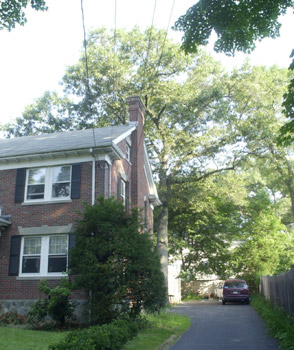 And there was a towering Red Oak tree just to the rear of the house.
And there was a towering Red Oak tree just to the rear of the house.
It stood about half way back in our property, straddling the patio and driveway, less than six feet from the house itself. We looked up at it with emotions that ranged from appreciation to apprehension. We appreciated its canopy over our picnic table, but from under the shelter of an umbrella to shield our dinner from its droppings. We wondered when (and where) a large dead branch would fall. We looked with dismay at the healthy growing things in our second story gutters. The growing things that were not oak were probably dropped by the squirrels that enjoyed its upper branches. We raked its leaves and swept its acorns in the fall. We wondered idly what the roots of a tree that vast might be doing to foundation and pipes so close.
In short, we appreciated and admired the tree, and tolerated the consequences of living beneath it. Things remained this way until we decided to expand our home by building an extension out from our kitchen — directly beneath The Tree. We reevaluated the situation at this point and concluded that the best interests of The Tree were not directly aligned with the best interests of our home. As you might gather from my use of the past tense, this is the story of how we dealt with the situation. It is not a story of disposal, but rather of a “re–purposing.” It is, in short, the story of how a venerable oak tree behind our house became a stack of curing lumber behind our garage.
It was not an easy decision to make. Cutting an old, healthy tree for no other reason than that we didn’t like where it had chosen to grow stood in stark contrast to my feelings about conservation, preservation and respect for nature. 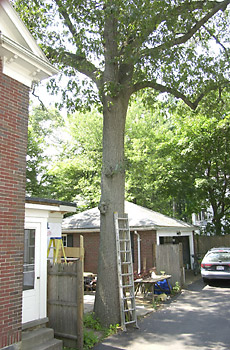 However, as this photo illustrates, it was awfully big and awfully close to the house. (The extension ladder was placed for scale: the ladder is 10 feet high. We calculated the diameter at about 32 inches.) The decision to remove the tree was unavoidable. The question then became — could anything be done to preserve even part of it? Was there a way to avoid disposing of it as simply waste?
However, as this photo illustrates, it was awfully big and awfully close to the house. (The extension ladder was placed for scale: the ladder is 10 feet high. We calculated the diameter at about 32 inches.) The decision to remove the tree was unavoidable. The question then became — could anything be done to preserve even part of it? Was there a way to avoid disposing of it as simply waste?
Of course there are always ways. The next question was, could a practical, or at any rate affordable way be found? Asking this question of everybody I ran into for a month led me to the LongLeaf Lumber Company in Somerville, Massachusetts. Longleaf Lumber is a fascinating company, an antique lumber salvage and milling operation, but they don’t deal with green wood and they were leery of trees harvested from back yards because of the likelihood of hidden metal. They did however inform me that what I wanted was an individual with a “portable saw mill”, and in fact they knew of such an individual in Wilmington, Massachusetts — Jim Cripanuk of Cripanuk & Associates. But before we get to that part of the story, I guess the tree has to come down first.
Process
The Arborists
I contacted several local tree services, and settled on the New England Tree Company, out of Canton, Massachusetts. After several false starts due to weather and equipment related issues, Chris showed up at 9:00 in the morning of August 21 with a five man crew, an enormous crane and a voracious chipper. It went pretty much as I expected: we were breathless spectators as the professionals did their work. The pictures tell the story, more or less. Your imagination will have to supply the roar of the chipper and the sharp scent of cut oak.
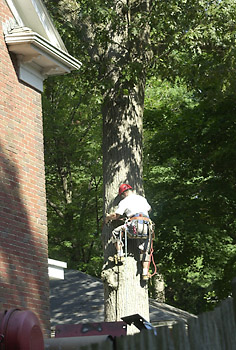
The initial ascent of the tree.
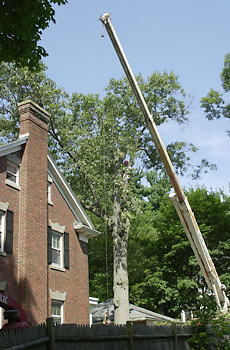
the towering crane
For most of its length, our driveway is scarcely wider than one car. The house is on one side; a neighbor’s stockade fence borders the other side. Because the limbs cut by the man in the tree were much longer than the driveway is wide, the crane operator needed to exercise both skill and patience while aligning the dangling branches with the length of the driveway. Remarkably, this was done over and over again without incident.
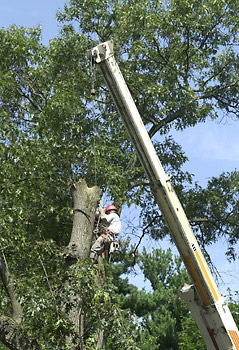
attaching the crane’s cable to a limb
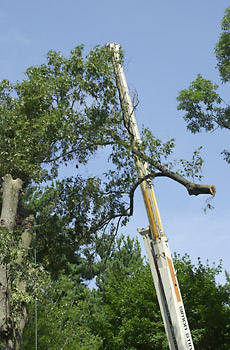
limb suspended
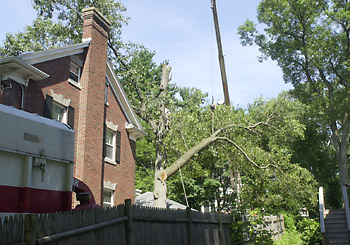
branch gracefully lowered
The crane was placed at the far end of the driveway (in front of the garage). A huge chipper was placed at the street end of the driveway, just outside the dining room window.
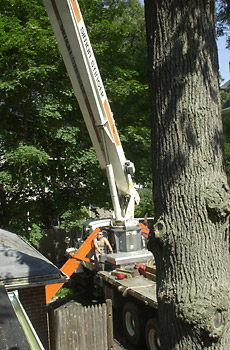
the crane operator’s perspective

the powerful chipper
It was really remarkable to watch the man in the tree. With considerable grace (considering there was a chain saw dangling from his belt) he would evaluate which branch to cut next, communicate that to the crane operator, snag the strap at the end of the crane, secure it to the branch, wait for the crane to apply some tension and then make the cut. Despite the distance between them, visibility problems due to leaves, and the roar of the chipper, their ability to communicate effectively was fascinating.
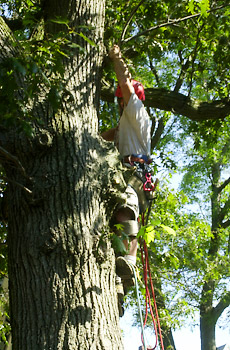
climbing to a new branch
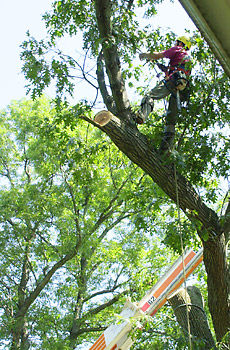
a quick rest while the crane lowers a branch
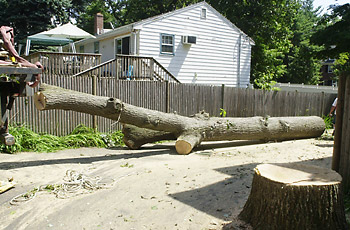 By about 1:00 the trunk lay in the driveway. The portion that divided into branches was cut and loaded on the truck. That left 16 feet of quite straight trunk. This was cut into two 8 foot sections and the arborists were nearly done.
By about 1:00 the trunk lay in the driveway. The portion that divided into branches was cut and loaded on the truck. That left 16 feet of quite straight trunk. This was cut into two 8 foot sections and the arborists were nearly done.
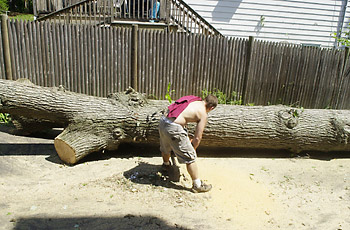
cutting trunk into sections
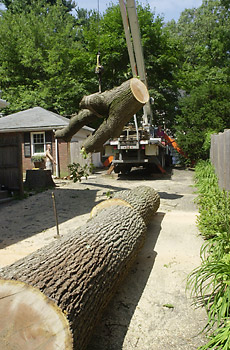
removing crotch of trunk
The Saw Mill
learning where lumber comes from…
Jim Cripanuk had arrived with his saw mill at about 11:30. As he did not have a portable crane, we needed to get the saw mill into place and the logs lifted onto it before the arborists and their crane left.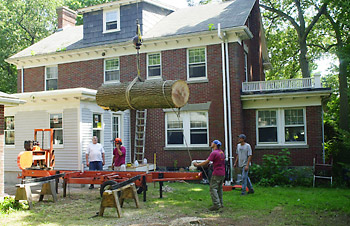 The chipper pulled out of the driveway, Jim’s pickup backed the saw mill up the driveway, and manpower rolled it into the back yard. By about 1:30 the two heavy logs had been lifted into place: one on the bed of the saw, the other on steel arms supported by saw horses, the idea being that we would roll the second log onto the saw bed after the first was completed. Easier said than done it turned out, but I was still an innocent at that hour.
The chipper pulled out of the driveway, Jim’s pickup backed the saw mill up the driveway, and manpower rolled it into the back yard. By about 1:30 the two heavy logs had been lifted into place: one on the bed of the saw, the other on steel arms supported by saw horses, the idea being that we would roll the second log onto the saw bed after the first was completed. Easier said than done it turned out, but I was still an innocent at that hour.
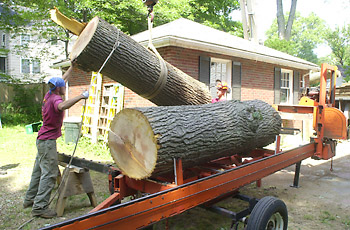
second section guided into place
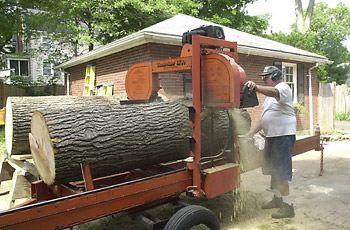 This picture shows the start of the first slice of the first log. The saw mill itself is essentially a gasoline powered, horizontally oriented band saw. The head of the saw travels the length of the bed with a racket and a shower of sawdust. Jim started up the mill and the first couple of slices came off neatly. So far, so good. Unfortunately, the limit of the saw’s throat is about 28 inches, and our logs were several inches wider than that. After a few slabs had been cut from the perimeter the log got too wide. The solution was to rotate the heavy log 90 degrees on the saw bed, take off a few more slabs, rotate it again and so on.
This picture shows the start of the first slice of the first log. The saw mill itself is essentially a gasoline powered, horizontally oriented band saw. The head of the saw travels the length of the bed with a racket and a shower of sawdust. Jim started up the mill and the first couple of slices came off neatly. So far, so good. Unfortunately, the limit of the saw’s throat is about 28 inches, and our logs were several inches wider than that. After a few slabs had been cut from the perimeter the log got too wide. The solution was to rotate the heavy log 90 degrees on the saw bed, take off a few more slabs, rotate it again and so on.
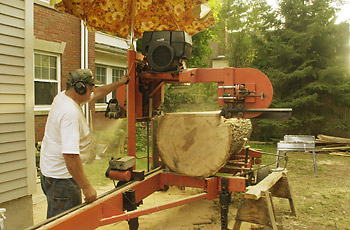 About this time came the dawning realization that this was a two man job (at least), and Jim had come by himself! For the next eight hours the few adrenalin–fueled emotions I had time to indulge progressed through adventure, anxiety, despair and finally accomplishment. The photo coverage ends fairly early because I was soon too busy and too tired to even consider taking pictures.
About this time came the dawning realization that this was a two man job (at least), and Jim had come by himself! For the next eight hours the few adrenalin–fueled emotions I had time to indulge progressed through adventure, anxiety, despair and finally accomplishment. The photo coverage ends fairly early because I was soon too busy and too tired to even consider taking pictures.
Looking at the pictures weeks later, the logs don’t look that daunting. But trying to persuade a log significantly taller than me, and wider than I could reach around, to roll over (or even wiggle for that matter) gave me a rich appreciation for what green oak weighs. “Brawny” is not a word that would spring to mind were one to attempt a description of my physical presence, nor is “burly”. All we had to work with were log rolling hooks and determination. The accomplishments of this land’s early settlers stagger me.
There were many moments when I honestly thought Jim’s rig was probably going to remain in our yard permanently as some sort of monument to naive enthusiasm. Fortunately, Jim proved to be tireless and far more optimistic than I.
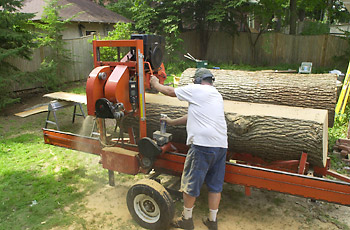
another view of the saw in action
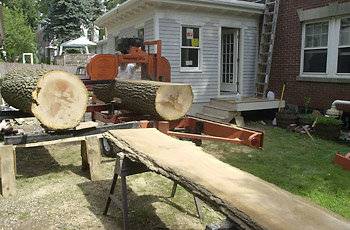
foreground shows one of the rough “slabs” before the edges were trimmed
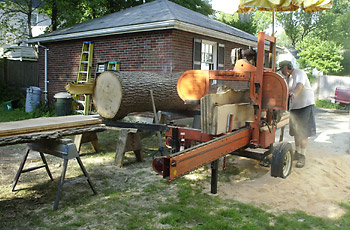
several slabs placed back on the mill to have cleanly cut edges.
It was long after dark when we finished. Jim cut most of the planks 12 inches wide by 1 inch thick, though there are also a number of 10 and 8 inch planks. I left the planks stacked on top of each other in the yard that night.
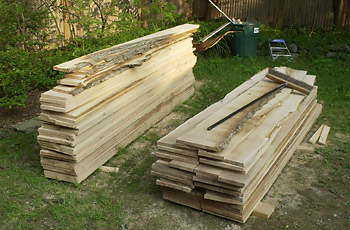 This photo, taken the next morning, shows the quantity of lumber the red oak trunk yielded. Not shown is an extensive and much less orderly pile that didn’t quite make it as lumber. This will be offered to friends as firewood.
This photo, taken the next morning, shows the quantity of lumber the red oak trunk yielded. Not shown is an extensive and much less orderly pile that didn’t quite make it as lumber. This will be offered to friends as firewood.
 Stacking the planks properly for seasoning had to wait until Saturday. The first layer is elevated above grade by the height of two cinder blocks. Each layer has five 12 inch boards or the equivalent. There are 13 layers, each separated from the other with 1x3 inch strapping for air circulation. If I did everything right, by next summer I should have quite a quantity of native red oak to work with.
Stacking the planks properly for seasoning had to wait until Saturday. The first layer is elevated above grade by the height of two cinder blocks. Each layer has five 12 inch boards or the equivalent. There are 13 layers, each separated from the other with 1x3 inch strapping for air circulation. If I did everything right, by next summer I should have quite a quantity of native red oak to work with.
The Conclusion
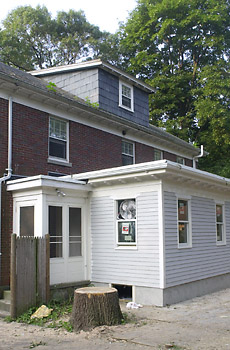 Here’s the back corner of the house, showing our new extension and a stump where a tree once stood. The chain saw left the stump too rough to be able to count rings. I tried smoothing a section with a hand plane, and the next time it rained the rings were easier to count — 125 as best I could tell!
Here’s the back corner of the house, showing our new extension and a stump where a tree once stood. The chain saw left the stump too rough to be able to count rings. I tried smoothing a section with a hand plane, and the next time it rained the rings were easier to count — 125 as best I could tell!
I don’t yet have an answer for the question everyone asks: what am I going to make with the wood once it is seasoned? This was clearly a cart–before–the–horse project. The tree needed to come down and the lumber needed to be harvested. I have all winter and spring to think of a fitting project.
-- top --